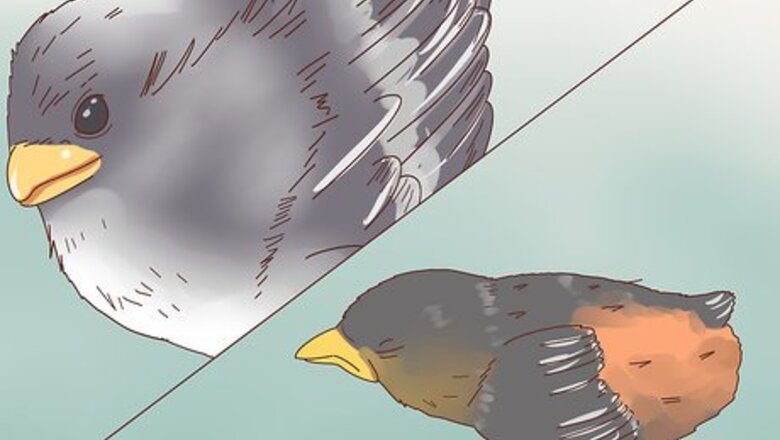
views
Determining if the Baby Bird is a Nestling or Fledgling

Check the baby bird's feathering. A baby bird is classified as either a nestling or fledgling, depending on its age. A nestling is a very young baby bird that doesn't have much feathering. A fledgling is older than a nestling and has more feathers, but does not yet know how to use his wing feathers to fly. Nestlings should not be out of their nests since they are unable to fly or grip a perch. Nestlings are altricial, meaning they are completely dependent on their parents and must stay in the nest. Songbirds and perching birds are born as altricial chicks. Fledglings tend to look a little scruffy overall.
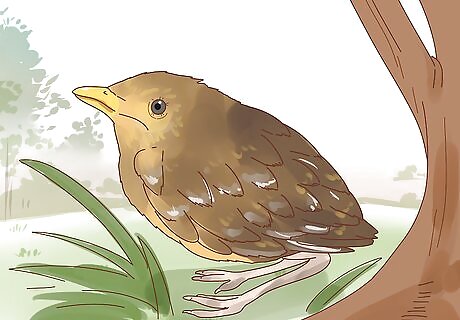
Observe the baby bird's behavior. If the baby bird is a fledgling, it will probably be prancing or scurrying about on the ground, since it hasn't learned how to use its muscles and feathers to fly. Chances are that the fledgling fell out of its nest—fledglings can become impatient with getting out the nest, but end up falling out rather than gracefully flying out. Although nestlings cannot move around on the ground, they will stretch their mouths wide open to ask for food, and will even chirp if you don't give them any!
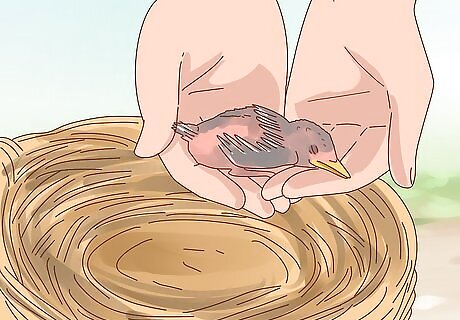
Put the nestling back in its nest. Before trying to identify the species of the baby bird, you should move it out of harm's way, especially if it is a nestling. If you can locate the nest from which the nestling fell, gently pick the nestling up (bare hands or with a towel) and place it back in the nest. If you cannot find the nest, you can make one. To make your own nest, line a shoebox or woven basket with hay or dry leaves. Place the makeshift nest off the ground with the baby bird inside of it and wait for about an hour for the parents to return. If the parents do not return, you will need to start making plans to take the baby bird to a wildlife rehabilitation center. It is only a myth that handling a baby bird will cause it to be rejected by its parents. If the nestling feels cold to the touch, warm it in your hands before returning it to the nest (or your makeshift nest). A parent returning to the nest may push out a cold nestling to prevent the other eggs or nestlings from becoming cold.
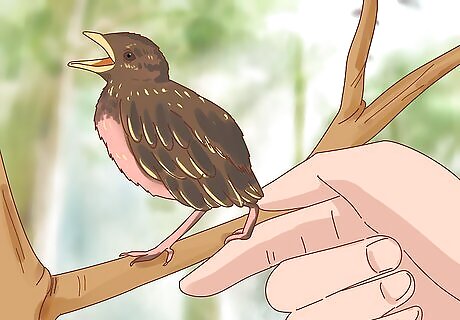
Place the fledgling onto a perch. Although out of the nest, a fledgling does not need to return to its nest. Since fledglings are able to use their feet to grip, hold out your index finger like a perch and use a bird treat to encourage the fledgling to perch on your finger. Once the fledgling is on your finger, gently place it on some shrubbery or a tree branch. If the fledgling does not want to perch on your finger, try gently wrapping it in a towel to pick it up and place it on higher ground. If you try to place the fledgling back in its nest, it will likely fall out of the nest again. The fledgling needs to be above the ground to protect it from predators.
Observing a Baby Bird's Physical Characteristics and Nest
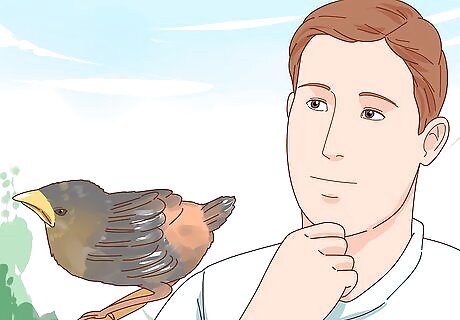
Recognize the challenge of identifying the species of the baby bird. It is often difficult to determine the species of a baby bird. Baby birds typically do not resemble their adult counterparts, particularly in terms of feather color and length. In addition, a baby bird's feather color and lengths can change in a matter of days, making identification even more difficult. Despite the challenges, do your best to identify the species. When you contact a wildlife rehabilitation center, you can provide them with this information so the staff will have a good idea of what type of baby bird you will be bringing them. If you need to care for the baby bird before transferring care over to a wildlife rehabilitation center, you can provide the bird with general support regardless of its species. For example, you can keep it warm by placing it in a tissue-filled shoebox (make sure to cut holes in the lid) and setting a heating pad set on 'low' underneath the box. You could also feed it.
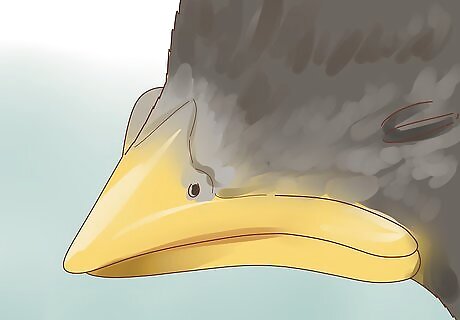
Look at the baby bird's bill. Often, a baby's bird bill will be large and out of proportion to the size of its head. This is because the baby bird's head has not yet fully formed. Essentially, the head will have to catch up to the size of the bill.
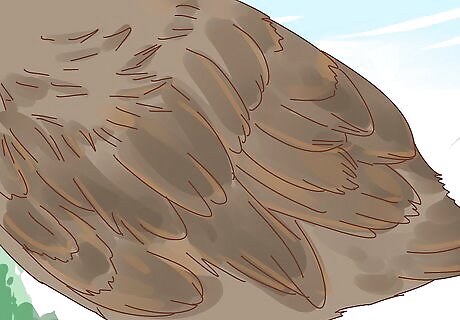
Observe the feather length and color. A baby bird's feathers are typically stubby, fluffy, and not very well organized. Sometimes, the feather coloring will resemble that of an adult of the same species, especially for the wing and tail feathers. Most times, though, the coloring will be very drab to conceal the baby bird from predators.
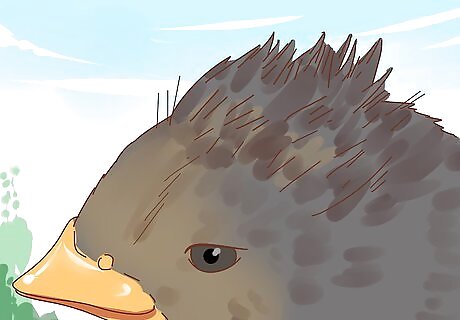
Identify other interesting physical features. With so many species of birds, there are many variations on physical characteristics. Some other physical features to look for include eye size, the presence of a hooked beak, and spiked feathers on the head. Be mindful that telltale physical features of a particular species may not be easily noticeable on a baby bird. The orientation of the toes (how many face forward and how many face backward) can also help you identify the species.
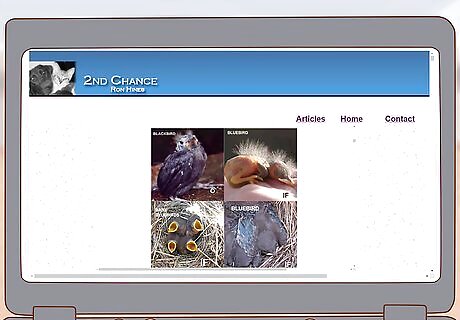
Use a picture database to identify the baby bird's species. Take a few pictures of the baby bird and spend some time researching online databases to see if you can identify the species. There are many helpful online resources, such as http://www.2ndchance.info/babybirdphotos.htm, that contain numerous pictures of baby birds.
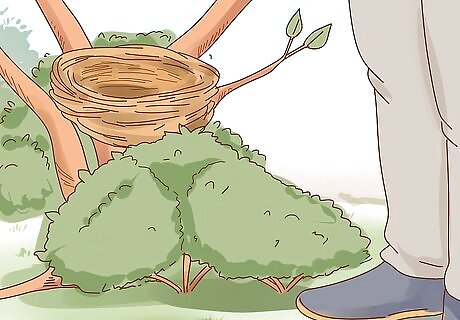
Observe the nest type to identify the species. If you were able to locate the nestling's or fledgling's original nest, you could use the nest's characteristics to determine the baby bird's species. For example, sparrows will make their nests close to the ground and wrens will build their nests in bushes or shrubs with dense foliage. Also, owls and wrens will make their nests in cavities of old trees. You can also look at how the nest is made. For example, American robins will have cup-shaped nests, Barn swallows will make their nests out of mud, and hummingbirds will make their nests out of lichens and spiderwebs. There are many types of nests, so do not become discouraged if you cannot identify the baby bird's species according to its nest. A wildlife rehabilitation expert can help you.
Knowing What to Do With the Baby Bird
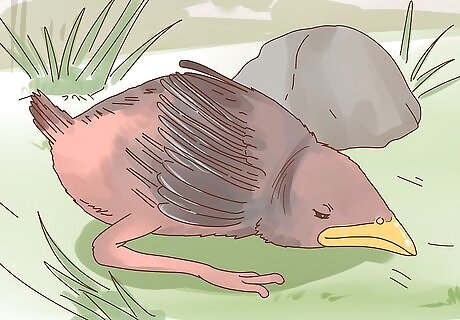
Determine if the baby bird needs your help. More times than not, it is best to leave a baby bird alone. Even if you do not see its parents around, chances are that the parents are not far off and will return to the nest (or ground) to feed it. However, if you see evidence of physical trauma (e.g., broken beak, missing or injured feet, puncture wounds), you should transport the baby bird to a veterinarian or wildlife rehabilitation center. The baby bird will also need your help if it is sick (e.g., cold to the touch, weak). For a nestling, you may need to take the baby bird for further care if the parents have not returned in an hour. Keep in mind, though, that the parents may not approach the nest if you are too close. Stay at least 100 feet (about 30 meters) from the nest. A nest with dead baby birds is abandoned. Any surviving baby birds will need help.
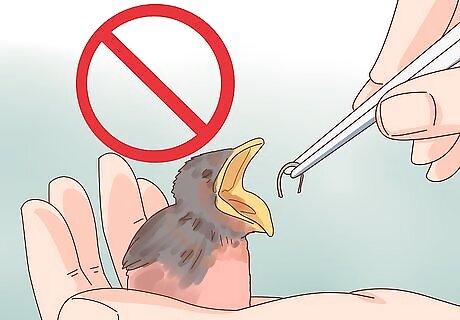
Do not hand raise a baby bird. This cannot be emphasized enough! Unless you are a licensed wildlife rehabilitator, it is illegal to hand raise wild animals in captivity. In addition to being unlawful, hand raising a wild baby bird is extremely time intensive—nestlings need to be fed every 15 to 20 minutes. Even with the best of intentions, it is unlikely that you will do a better job of raising a baby bird than its parents or a wildlife rehabilitator.
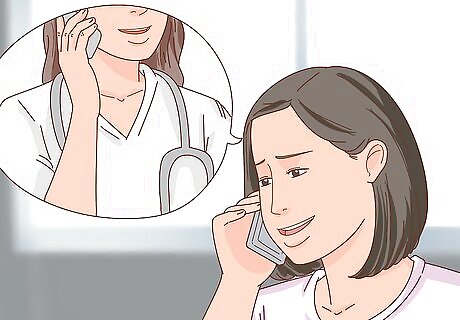
Contact a veterinarian or wildlife rehabilitation center. If you choose to take the baby bird to a veterinarian, find one that specializes in birds and wildlife. If you do not know the wildlife veterinarians in your area, your local zoo or ASPCA can give you recommendations. Search for the nearest wildlife rehabilitation center, both within the United States and internationally, by using a directory, such as the one at https://www.humanesociety.org/resources/how-find-wildlife-rehabilitator.
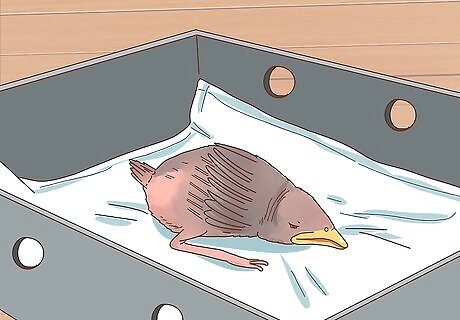
Transport the baby bird. To transport the baby bird safely, gently place it in either a cardboard box or shoebox with holes cut out for adequate ventilation. Place a towel in the box's bottom so the baby bird does not slide around in the box. To minimize the chances of you getting injured while picking up the baby bird, wrap it up completely in a towel (including the head and feet). You could also line the bottom of the box with paper towels. Handle the baby bird as little as possible before transporting it to minimize its stress.














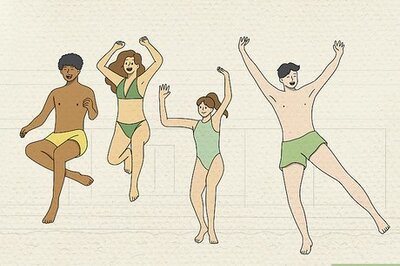


Comments
0 comment